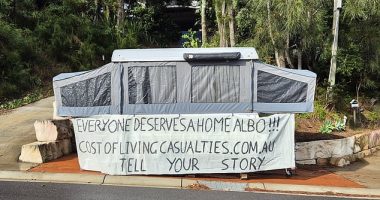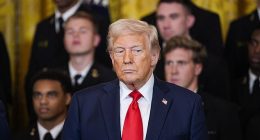SACRAMENTO, Calif. — Pain and soreness in OG Anunoby’s elbow isn’t surprising given the limited time after the operation, according to three surgeons who spoke to The Post.
And without rest, they say, the issue is manageable but can also linger.
“He needs to shoot, he needs to practice, but at the same time, he needs to rest,” Dr. Leon Popovitz, co-founder of New York Bone & Joint in NYC, told The Post. “But he’s a professional athlete, he needs to get out there. This is probably going to be something he feels the next few weeks. Resting and ice whenever he’s not practicing is super important.”
The tenderness of Anunoby’s joint was on display Thursday night in Portland, where the forward grimaced in pain and held his joint after sticking his arm out for a successful steal.
Anunoby continued to play but intermittently touched and flexed his elbow, as if bothered by discomfort.
It was his second game back since undergoing elbow surgery to “remove loose bone fragment” in early February, and the sight of his wincing was worrisome considering his recent procedure.

Anunoby downplayed the pain after the victory, saying “he was fine” while assuring his availability for Saturday’s game against the Kings.
The lack of concern, from both Anunoby and Knicks coach Tom Thibodeau, was understandable to Dr. Salil Gupta, a clinical assistant professor at NYU.
“If it happens here or there, or if it happens just a couple times incidentally, it’s not that concerning,” Gupta told The Post. “And you’d expect that to happen in the first several weeks or couple months after the surgery. I think it’s more of a question if it happens more and more consistently. If it happens with noncontact activities, moving and shooting. If he ends up getting swelling after the game — which is going happen a little bit — but if it’s really dramatic and he has difficulty moving the elbow, those kinds of things. … But at six weeks [after the surgery], having a couple episodes of pain during a high-intensity game isn’t overly concerning.”
As the surgeons noted, there are some important qualifiers to their assessments.
None of them examined Anunoby nor reviewed his medical records, and they can only assume — not know — that the player did not undergo any reconstruction or repair during the arthroscopic surgery.
Plus, they don’t know how Anunoby physically reacted to his pain from Thursday.
The Knicks didn’t practice Friday in Sacramento.
“I would be concerned if his elbow was swollen, which it may be. I would be concerned if he didn’t have full range of motion in his elbow,” said Dr. Andrew S. Rokito, chief of the Division of Shoulder and Elbow Surgery at NYU Langone Orthopedics. “And I would be concerned about how much pain he’s in. All of those things would factor into my level of concern. And if all those boxes would check off, it would necessitate a more extended period of rest.”
Even if there’s no inflammation, Rokito, who was a surgeon for the Mets in the early 2000s, said he might recommend rest for Anunoby.
“Out of an abundance of caution, we could rest him a couple games and give him another try. Or, if he looks good in practice, has no pain, let him go at it again,” Rokito said. “I wouldn’t be fearful of letting him play from the standpoint that he would do some irreparable structural damage to his elbow. I would be more concerned that if he played and the elbow was inflamed, it would just not give it a chance for that inflammation to go away.”

The consensus is rest is the best way to avoid pain but maybe not necessary.
“I would recommend resting to alleviate the symptoms, but he’s a professional athlete and he’s an important part of the team,” Popovitz said. “So if he really needs to [play] and he wants to at this stage, he can.”
Without rest, though, there is a threat of pain and soreness that lingers.
“Maybe. If he continues to have discomfort, and he continues trying to play through it, then he may end up needing to be shut down again at some point,” Gupta said. “Unpredictable but that’s your fear.”






